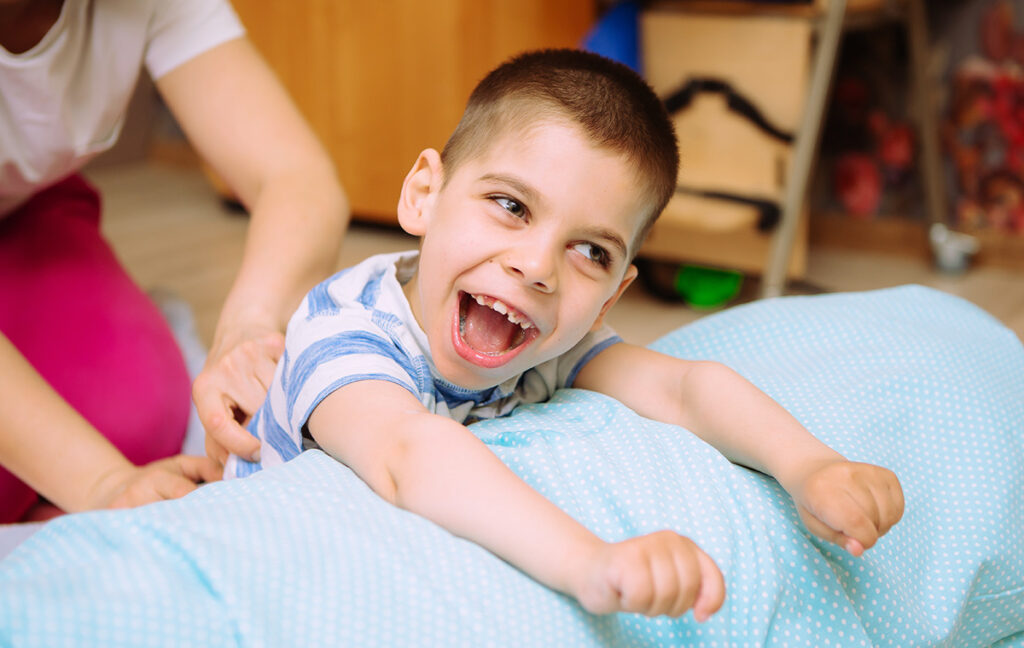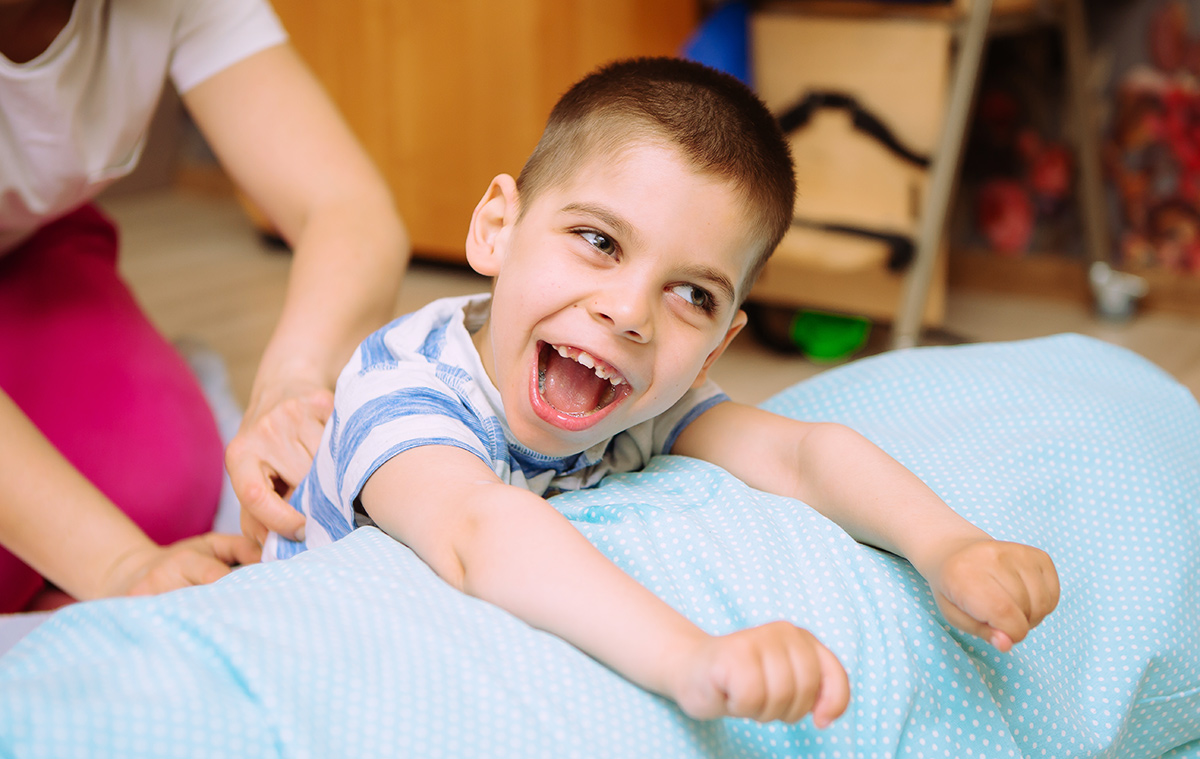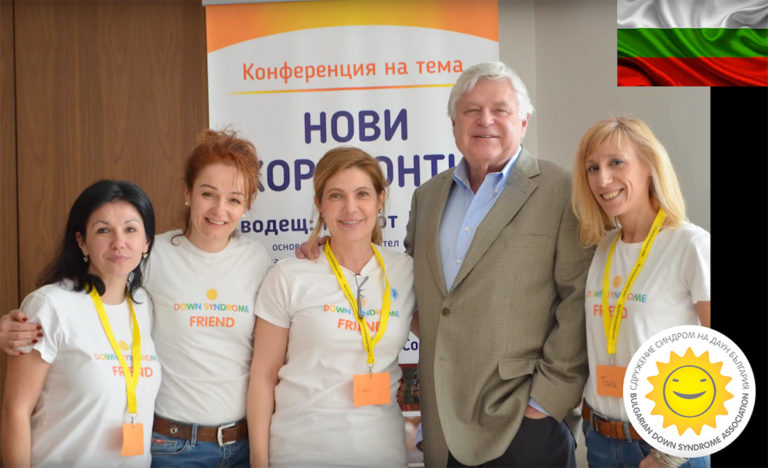Cerebral Palsy
by Robert J. Doman Jr.
THE PROBLEMS
 The first problem faced by the parent of a hurt child is to discover just what it is that their child is, or has. Whether the child’s problem is discovered at birth, or a week, a month, or years after birth, or even if the problem is created by some trauma such as an automobile accident during the teenage years, the problem of discovering exactly what has happened is immense for most parents.
The first problem faced by the parent of a hurt child is to discover just what it is that their child is, or has. Whether the child’s problem is discovered at birth, or a week, a month, or years after birth, or even if the problem is created by some trauma such as an automobile accident during the teenage years, the problem of discovering exactly what has happened is immense for most parents.
Most people are extremely ignorant in regards to hurt children. Their limited information usually comprises a collection of “old wives tales,” and a few details about a child belonging to some distant relative or neighbor. As traumatic as the discovery that you have a hurt child is, the lack of information intensifies that trauma all the more.
The family physician who helped you through your last case of the flu, or who correctly diagnosed your neighbor’s heart condition often disappoints you in regards to your hurt child. He frequently cannot even tell you what is wrong with your child, let alone what to do about it. All too often his suggestion is to institutionalize the child as soon as possible. Doctors commonly wish that the problem would simply go away. Either at your doctor’s recommendation, or because of our own need for information, you may search further for answers by going to see a “specialist.” The specialist usually takes the form of a neurologist, neurosurgeon, orthopedist, or a psychiatrist. The visit with the specialist often is an even more upsetting and frustrating experience than the visit with the family doctor, because the “specialist” should know.
Why doesn’t your doctor know? Why doesn’t the specialist know? Quite frankly, they don’t know because almost no one knows! What is known about the brain today is extremely limited, and of what is known, much of it has just been learned in the last twenty years.
Some diagnoses are relatively easy to make, such as Down Syndrome, with physical signs which can be seen and chromosome tests which can be used for confirmation. Or to a lesser degree, cerebral palsy, which is used to describe most children with obvious motor problems. But even with these problems, if you ask the physician exactly where the problem is, or what is going to happen to the child, the answers will probably be vague. Unfortunately however, of all the questions asked, the one which is generally answered with the greatest frequency and confidence is the one about which the least is known. That is, what is to become of my child, or what is the prognosis (outlook). Every hurt child is different and almost every hurt child has a chance, if given the opportunity. If every doctor’s response to the question of prognosis is simply that he doesn’t know, and not that it is hopeless, many, many, more hurt children would improve, and some would have the opportunity for “normal” lives.
SYMPTOMATIC DIAGNOSIS
In order for the parent to begin to understand the nature of their child’s problem, it will be necessary to explore the vague and contradictory terminology applied to children with problems.
Of the many terms used to categorize children with problems, few are attempts to describe the source of the problem, rather they are descriptions of the symptoms. In that a child may possess a variety of symptoms, a number of different symptomatic labels may be attached to each child. In addition to the problem of more than one term being applicable to an individual child, there is within the fields dealing with such children tremendous difference of opinion and controversy over the definitions and applications of specific terms. A thorough discussion of terms could easily comprise an entire volume in itself, and is outside the scope of this particular text. I wish only to give the parent some understanding of terms which may be applied to their child.
In order to simplify the parent’s task of acquiring some understanding of the various terms, I will endeavor to define each specific term as it relates to the general term of cerebral palsy, and as it affects or relates to a child’s functional abilities.
CEREBRAL PALSY
Cerebral Palsy is a term applied to a group of individuals whose primary handicap is physical, as opposed to mental. These children, as a group, exhibit problems which affect their ability to gain mobility (crawling, creeping, walking), to use their hands (eating, writing, dressing), and to verbalize or talk. This large group is subdivided into lesser groups based primarily upon the specific way in which their muscles, or the control of their muscle function, is abnormal. Within each group the level of severity varies, as well as the areas of the body which are affected. There is also a great deal of overlap. That is, within one child you may see many types of cerebral palsy, or the child may exhibit different forms at various times during development.
Except in very severe cases where an obvious injury has occurred (generally around the time of birth) a child may not be diagnosed until six to twenty-four months following birth, as it may be this long before the symptoms become obvious.
Cerebral palsy may develop as the result of an injury to the central nervous system before, during, or after birth.
The primary classifications of cerebral palsy according to the location of involvement and in frequency of occurrence are:
- Quadriplegia: Involvement of both arms and both legs.
- Hemiplegia: Involvement of one side of the body, the arm and leg on either the right or left side.
- Diplegia or Paraplegia: Involvement of both legs.
- Triplegia: Involvement of three extremities, usually both legs and one arm.
- Monoplegia: Involvement of only one limb.
The classifications of cerebral palsy according to syndrome, and in order of frequency are:
SPASTIC
The most common form of cerebral palsy is spastic cerebral palsy. The term “spasticity” refers to the function of individual muscles within the child’s body. When a child with spasticity attempts to move the involved limb, or if someone attempts to stretch an involved muscle, the muscle responds with a strong contraction, or tightening. In that the muscle flexion is centered in the flexor muscles, the opposing extensor muscles often become stretched and lose some of their functional ability. If a limb remains in a state of extreme tightening of the flexor muscle, causing a stretching of the extensor for extended periods of time, a condition develops which is known as a “contracture,” in which the function of the limb is almost completely inhibited.
Spastic involvement of the legs generally results in some degree of “scissoring.” The spastic muscles of the legs tend to limit knee movement, while the spastic adductor muscles (inner thigh) of the legs draw the legs inward until they actually cross each other. This motion also tends to rotate the legs inward at the hips, pulling the leg away from the hip socket. In addition, the flexor within the calf tends to pull the heel up which pushes the toes down and rotates the foot inward.
Spastic involvement of the arms results in some degree of tightening of the flexor muscles, so as to pull the elbows in toward the sides of the body, and the hands and wrists toward the chin. The backs of the hands tend to come together, and the fingers flex into a tight fist. The thumb generally is flexed to such a degree as to draw it against the palm of the hand, with the spastic fingers curled over it.
Associated with the spastic child one often finds an exaggerated startle response to stimulation, inefficient respiration, curvature of the spine (which results from remaining in an upright position without the necessary development of the trunk muscles which would permit the child to support his spine), and failure to develop normal hip sockets because of his difficulty in achieving normal movement of his legs. Various visual problems, such as nystagmus (vibration of the eyes) or strabismus (lack of convergence the eyes’ inability to work together in unison), are also evident. In addition, many spastic children exhibit abnormal electrical activity in their brains with associated seizure activity. In some cases, spastic children also suffer from some loss of mental ability.
The author would be remiss if he were not to mention the role of orthopedic surgery in the spastic child. Although orthopedic surgery is thought by many to be indicated in some spastic children, particularly for heel cords, hamstrings, adductors, and hips, it is becoming less popular due to the understanding that the spastic child’s problem is his brain and not his muscles, per se, that rehabilitation can often correct such problems without surgery, and that surgery often presents not only a delay to rehabilitative therapy, but a complication often greater than the original problem. For every action, there is a reaction. If the orthopedist cuts a spastic muscle because it is producing an abnormal pull, when the child reaches the developmental age when the cut muscle should be doing its normal job, that developmental movement of the limb will be lost or will be very abnormal. For example, if spastic adductor muscles are cut because they are causing the legs to scissor, their later function of holding the legs directly under the body, when creeping on the hands and knees or walking, will be lost and the legs will tend to spread, causing the child to have difficulties trying to hold the body up straight.
ATHETOSIS
The athetoid child is one of the most perplexing children there is to work with. He is generally an extremely happy child, a delightful, cheerful, optimistic, bright child, whose progress is often extremely slow and difficult.
The athetoid child’s muscles, although a bit hyper (increased) in tone, react in very abnormal fashion, and the harder the child tries to correct an activity the more uncontrolled his movements become The abnormal motor function of the athetoid is in the form of excessive movement and uncontrolled movement. This uncontrolled movement increases with the child’s effort to move with his level of excitement or with environmental stimulation. With excessive stimulation, the athetoid’s body flails rapidly and wildly. With relaxation, the abnormal function decreases, and with sleep, disappears.
The athetoid, upon stimulation, assumes an “extensor thrust” position which is characterized by the arms being rapidly extended outward and back, with the palms of the hands toward the floor and fingers over extended and spread. While the knees come together, feet turn inward and toes turn up. The neck flexes pulling the head back and to the side and the mouth opens and tongue protrudes.
In addition to the athetoid’s movement, which can be described as irregular, unpredictable, and writhing, his efforts toward mobility are further complicated by an extremely poor sense of balance. The athetoid who has gained the ability to walk often resembles the lurching, balance adjusting movement of someone trying to walk across the deck of a ship being tossed about in a storm. Characteristically, an athetoid’s attempts at such movements as the opening and closing of a hand are accompanied by overflow movements involving all the extremities.
The involvement of the athetoid’s mouth and throat make the activities of eating, drinking, and speaking extremely difficult. As with the spastic, respiration is also irregular and shallow, adding to the overall problem by providing insufficient oxygen to the brain and increasing the chance for respiratory infections.
TREMOR
The child with the form of cerebral palsy known as tremor, is hampered by involuntary movement as is the athetoid, but of a different nature. As the name implies, this child is affected by an almost wave-like shaking that results from an alternate contraction of flexor and extensor muscles.
The tremor in such involved children is greatest in fine rather than gross activity, so that the greater force which the child can exert, the lesser the influence of the tremor.
RIGIDITY
Rigidity is generally associated with severity of involvement. The child with rigidity is characterized by simultaneous and continuous contraction of both extensors and flexors, with greater power being exerted by the extensors, resulting in a general lack of movement as opposed to inappropriate or involuntary movement. The limbs of the child with rigidity are virtually locked in full or over-extension, resulting in an arched position with the back stiff and head and feet at the extremes of the arch.
The child with rigidity such that permits some controlled movement of an extremity has the further complication of involuntary movement of the opposite extremity (movement of the right arm results in a similar movement of the left).
Various associated complications are generally seen with these children ranging from severe respiratory problems to diminished vision and hearing, as well as seizure disorder.
FLACCIDITY, ATONIA, ATAXIA
Flaccidity and Atonia are fortunately relatively rare. They are difficult to treat and must be differentiated from conditions of the muscle such as some forms of muscular dystrophy. Ataxia is a condition characterized by loss of balance and poor coordination. Such a child may have normal muscle strength and tone, but because the balance factors are inadequate, attempts at walking are difficult, dangerous, or most often, impossible. Such children have difficulty gauging the amount of movement they are making with an extremity and may miss their intended amount of movement by overextending or underextending the part.
CAUSE
Children diagnosed as having cerebral palsy are children who have brain injury. Injuries to their brains that have occurred before, during, or after birth. The injury to the brain indirectly is the cause of the lack of function within the children. The direct cause of the dysfunction is the dysorganization of the brain which is itself caused by the brain injury. The location and size of injury determines the degree to which the injury produces dysorganization.
Injury to the brain may result from a variety of causes. Prenatal injuries may be caused by maternal infections, trauma, metabolic disturbance, Rh incompatibility, malnutrition, hemorrhage, or anoxia (lack of oxygen). Injuries caused during the birth process include anoxia, hemorrhage, mechanical injury, or problems associated with pre or post mature deliveries. Following birth, injury to the brain can be caused by infections, trauma, toxic substances, or anoxia. Although those causes listed are but some of the possible causes of an injury to the child’s brain, they represent the major causes. Often the exact time or even cause of the injury is unknown, and in that the time or cause has very little influence upon treatment, it is best if the family does not pursue the issue if the specifics are not readily available.
STARTING POINT
The time and cause of the injury to the brain are of limited significance. The cause of the dysorganization to the brain is not, however. A diagnosis of cerebral palsy is a symptomatic diagnosis which indicates brain injury. A working diagnosis however, is indicated, a diagnosis based upon neurological studies which locate the injury, and which either eliminate the possibility of a progressive disorder or indicate a course of medical treatment or intervention.
TREATMENT
All cerebral palsied children are brain injured; however, all brain injured children are not cerebral palsied. The injury to the brain which results in the symptoms which lead to a label of cerebral palsy is associated with injury to the motor centers of the brain. The location of the injury determines the form of the dysorganization, and thus, the particular loss of function.
Children with brain injury and resulting loss of motor function often go undiagnosed until many months following birth. Although the injury occurred at the time of birth, the problem often does not manifest itself until the child is functioning at the level of the injury. For example, a child with a mid-brain injury would not necessarily have abnormal function until such time as he has developmentally reached that level. With the child labeled as being cerebral palsied, as with every other child lacking function because of neurological dysorganization, treatment is directed toward organizing the brain (stimulating the growth of brain connections) .
Brain cells that have died are not replaced. Neither are injured cells repaired. Through stimulation new connections grow between the healthy cells permitting those healthy parts of the brain to carry out the function of the injured or dead cells. The more connections between the brain cell bodies, the more efficient the system. The more efficient the system, the higher the level of function.
Cerebral palsy is a symptomatic diagnosis which does not identify the problem. Symptomatic treatment attempts to lessen the symptoms, not reach the cause. The problem with a spastic arm
is a problem with the brain. The problem with a rigid leg is a problem with the brain. Symptomatic treatment aimed solely at the limbs does not treat the cause of the problem – the brain!
Neurological organization is an ongoing process which can be accelerated by increasing the frequency, intensity, and duration of appropriate stimuli. Appropriate stimuli causes the growth of connections and a corresponding increase in function.
PROGNOSIS
The outlook for brain-injured children with a symptomatic diagnosis is not good. These children are generally treated symptomatically. Historically, as a result of inappropriate treatment, these children have failed to show significant improvement. There is no such disease as cerebral palsy. You can’t catch it. If you have it, you can’t give it to anyone else, neither can you get a “shot” that will make it go away. But because historically, children with this fictitious disease have failed, this fictitious disease is now viewed as an incurable disease. Viewed as incurable, these unfortunate children are often denied a real opportunity to improve.
Improvement in children with motor problems is often slow and difficult. There are very few “miracles.” But given the opportunity (an hour of therapy twice a week is NOT an opportunity), virtually all of these children can improve, and some can achieve “normal” function.
Opportunity for these children involves intensive treatment. Treatment which, because of it’s very intensity, requires the family’s involvement. Many hours per day are needed. Not per week, per day! Hours of specific stimulation. Stimulation which treats the cause, not the symptom. The problem – as well as the answer lies within the BRAIN.
The NACD Foundation is fortunate in being able to assist families of brain injured children in their efforts to help their children achieve their potential through individual evaluations, programming, parent education, and research.




